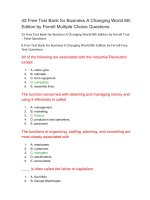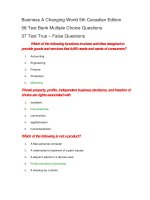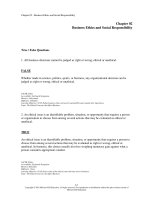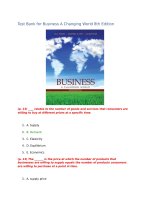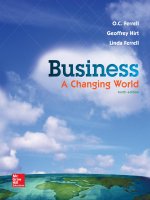Business a changing world 7e by ferrell chap016
Bạn đang xem bản rút gọn của tài liệu. Xem và tải ngay bản đầy đủ của tài liệu tại đây (2.03 MB, 34 trang )
16-1
Business in a
Changing World
Chapter 16
Financial Management and Securities
Markets
2
McGraw-Hill/Irwin
Copyright © 2009 by the McGraw-Hill Companies, Inc. All rights
16-3
Sears Holding Corporation –
Using brand names to create
bonds
Sears Holding Corporation (SHC) parent of Kmart
and Sears, Roebuck and Co.
16-4
Current Assets and Current Liabilities
• Current assets -- short-term resources
–
–
–
–
Cash
Investments
Accounts receivable
Inventory
• Current liabilities -- short-term debts
–
–
–
–
Accounts payable
Accrued salaries
Accrued taxes
Short-term bank loans
16-5
Current Assets
Working capital management – managing of
short-term assets and liabilities.
16-6
Managing Cash
Transaction balances – cash kept on hand by a firm
to pay normal daily expenses such as employee
wages and bills for supplies utilities.
16-7
Managing Cash
Lockbox – an address, usually a commercial bank, at
which a company receives payments in order to
speed collections from customers.
16-8
Going Green or Greenwashing?
Eco Chic line – products made with organic materials. The Pottery Barn
collection.
16-9
Managing Cash
Marketable securities – temporary investment of
extra cash by organizations up to one year in U.S.
Treasury bills, certificates of deposit, commercial
paper, or Eurodollar.
16-10
Managing Cash
Treasury bills– short-term debt obligations the
U.S. government sells to raise money.
Commercial certificates of deposit (CD’s) – issued
by commercial banks and brokerages available in
minimum amounts of $100,000 and can be traded
prior to maturity
Commercial paper – a written promise from one
company to another to pay a specific amount of
money
16-11
Managing Cash
Type of
Security
Maturity
Seller of Security
Interest Rate
5/23/08
Safety Level
Treasury bills
90 days
U.S. Government
1.82%
Excellent
Treasury bills
180 days
U.S. Government
1.87%
Excellent
Commercial
Paper
30 days
Major
Corporations
2.19%
Very Good
CDs
90 days
U.S. commercial
banks
2.62%
Very Good
CDs
180 days
U.S. commercial
banks
2.80%
Very Good
Eurodollars
90 days
European
commercial banks
2.75%
Very Good
Short-term Investment Possibilities for Idle Cash
16-12
Managing Cash
Eurodollar market – a market created in London
for trading U.S. dollars in foreign countries.
16-13
Accounts Receivable
Accounts Receivable – money owed to a business
by credit customers.
16-14
Optimizing Inventory
Optimizing inventory – minimize firm’s investment
in inventory without experiencing production
cutbacks.
16-15
Maximizing Current Liabilities
Accounts payable – money an organization
owes to suppliers for goods and services.
Trade credit – credit extended by suppliers for
the purchase of their goods and services
16-16
Bank Loans
Line of Credit -- An arrangement by which a
bank agrees to lend a specified amount of
money to an organization upon request
Secured Loans -- Loans backed by collateral that
the bank can claim if the borrowers do not
repay the debt
16-17
Bank Loans
Unsecured loan – loans backed only by the
borrower’s good reputation and previous credit
rating
Prime rate – the interest rate that commercial
banks charge their best customers for short
term loans
16-18
Non-Bank Liabilities
•
Short-term loans from insurance companies, pension funds, money
market funds, or finance companies
•
Factoring organization
– Purchases accounts receivable at a discount
•
Taxes and employees’ wages
16-19
Managing Fixed Assets
Long-term (fixed) assets – production facilities
(plants), offices, and equipment—all of which
are expected to last for many years.
16-20
Budgeting & Planning
Frequently
Occasionally
Rarely
How Reliable is Budgeting and Planning?
21
16-21
Capital Budgeting
Capital budgeting -- is the process of analyzing
the needs of business and selecting the assets
that will maximize its value
16-22
Highest Risk
Introduce a New Product in Foreign Markets (risk
depends on stability of country)
Expand into a New Market
Introduce a New Product in a Familiar Area
Add to a Product Line
Buy New Equipment for
an Established Market
Repair Old Machinery
Lowest Risk
Qualitative Assessment of Capital Budgeting Risk
16-23
Long-term Money
Profitability & Pricing Long Term Money
-Factors to Consider:
–
–
–
–
How much cash will be generated
Cost of financing
Supply of funds available for investment
Accurately identifying opportunities with the greatest
potential for ROI
16-24
Financing with Long-Term Liabilities
•
Debts that will be repaid over a number of years
– Long-term loans
– Bond issues
16-25
